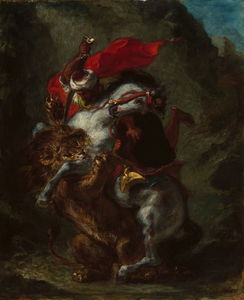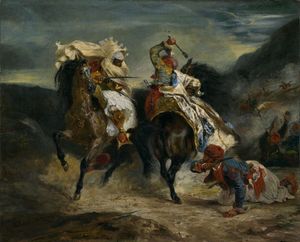Eugene Delacroix
- Full Name:
- Ferdinand Victor Eugène Delacroix
- Short Name:
- Delacroix
- Date of Birth:
- 26 Apr 1798
- Date of Death:
- 13 Aug 1863
- Focus:
- Paintings, Drawings
- Mediums:
- Oil, Pastel, Wood, Other
- Subjects:
- Figure, Scenery
- Art Movement:
- Romanticism
- Hometown:
- Charenton, France
- Eugene Delacroix Page's Content
- Introduction
- Artistic Context
- Biography
- Style and Technique
- Who or What Influenced
- Works
- Followers
- Bibliography
Introduction
Ferdinand Eugene Victor Delacroix, more commonly known as Eugene Delacroix, was a French painter who had a profound influence on the Romantic movement.
Known as a "master of color," Delacroix became a pupil of the English Romantic landscapists and extracted from their techniques, to develop a unique and memorable approach to color. The impact of literature and both historical and contemporary events, coupled with his innate artistic technique created an explosive viewing experience on canvas.
The settings around him also shaped his work; he traveled throughout Europe but Morocco seemed to have the greatest impact on him of all the places he visited.
Delacroix enjoyed a long and successful career, receiving countless commissions from the government. His violent subject matter, intense passion, and bright colors puzzled and offended some contemporary critics but earned the admiration of others.
Delacroix's paintings changed the art world forever and his technique had a lasting impact on the Impressionist and Post-Impressionist movements.
Today, Eugene Delacroix is remembered as one of the world's most influential French Romantic painters and his expertise and genius is fully recognized and appreciated by modern day art critics.
Eugene Delacroix Artistic Context
Romanticism is sometimes viewed as a reaction to its more serious predecessor, the Neoclassical movement. As Neoclassical artists focused on properly accounting history through close attention to detail, Romantic artists flirted with themes of man's self glorification, man's part in nature, divinity found in nature, and emotion.
Romanticism emphasizes the individual sense of self, creativity, imagination, and the value of art to make a statement. This emphasis on the individual is reflected in the ideas of self-realization through the act of contemplating nature.
There is the idea that the individual can only directly understand nature, free from society. Peace and salvation come through the individual rather than through political movements.
Romantic painters like Delacroix were part of a complex multimedia philosophical movement, involving the literary, visual, and intellectual arts.
Eugene Delacroix fine-tuned Romanticism, incorporating the influences of great masters such as Michelangelo and Peter Paul Rubens. He developed his own personal style, with an affinity for showing pain and suffering in his work through brightly colored canvases.
Eugene Delacroix Biography
Early Years:
On April 26, 1798 Eugene Delacroix was born in France to an artistic family. He began studying art at the age of 17 and was taken under the wing of academic painter, Baron Pierre-Narcisse Guerin.
Aged 24, Delacroix was put in charge of architectural decorations for another statesman, Adolphe Theirs. His early years were influenced by fellow Romantic artists as well as Polish composer and pianist Frederic Chopin.
Intermediate Years:
Early on, Delacroix's work demonstrated the influence of Michelangelo's and Peter Paul Rubens, as seen in Dante and Virgil in Hell which the artist exhibited to the Salon of 1822.
His next exhibition to the Salon of 1824 was Massacres at Chios: Greek Families Awaiting Death or Slavery which conveyed the bloody defeat of the Greeks by the Turks. Delacroix's ability to tap into the emotion of his subjects, both the haughty conquerors and the innocent victims, caught the attention of the art world.
Traveling to London just a year later, Delacroix studied the work of the English painters he greatly admired. He felt this trip had brought him closer to mimicking Rubens colorful style and this was evident in his 1830 work July 28: Liberty Leading the People.
Delacroix continued traveling, this time to Spain, Algeria and Morocco. His time in Morocco changed him forever; he was mesmerized by the foreign culture and continued to paint Arab subjects for the rest of his career.
Advanced Years:
Delacroix spent most of his mature years decorating the walls and ceilings of government buildings. These mural commissions made him feel closer to his idol, Michelangelo.
The canvases of his late career include The Battle of Taillebourg and The Taking of Constantinople by the Crusaders (April 12 1204).
Delacroix died in France in 1863. Besides many drawings, watercolors, and paintings, he left behind a legacy that forever changed the art world, specifically inspiring the Impressionist and Post-Impressionist painters.
Eugene Delacroix Style and Technique
Though his style had evolved over the years, Eugene Delacroix stayed true to his displays of emotion and intense colors. His expression was uninhibited and his canvases exploded with energy.
The artist never hid his fascination for destruction and violence and brought them to life through virtuous colors. He is still admired for his bold, technical innovations.
Early Years:
Before he could completely develop his own signature style, Delacroix experimented with those of the masters before him. He was somewhat self-taught from observing the works of Michelangelo and Peter Paul Rubens.
Aged 17 he pursued classical studies and this training was most evident in his early work. As a pupil of academic painter, Baron Pierre-Narcisse Guerin, he learned to paint according to life.
In his first masterpiece, Dante and Virgil in Hell, his unblended colors only took form from a distance. This technique would inspire the Impressionist movement.
Mature Period:
Delacroix continued to paint with great vividness and emotion. His 1824 work Massacre at Chios, which displays the killing of 20,000 Greeks by Turks on the island of Chios is a perfect example of his maturation in style.
At 27 Delacroix traveled to London, a trip inspired by his admiration for English landscape painters. Turner's bright watercolors and energetically colored canvases were an obvious influence on the artist, as was the work of Sir Thomas Lawrence. His technical skills developed during this time.
Delacroix's Liberty leading the People served to commemorate the recent French Revolution and this canvas reflected a change in the artist's style; he painted with passion and animation but the overall tone was a quieter one.
After visiting Morocco Delacroix handled his drawing and painting more freely. And his use of colors became even more sumptuous.
Late Style:
Delacroix's style wasn't altered dramatically as he aged but he did begin to work on a larger scale. He was commissioned to paint murals on the walls and ceilings of several government buildings.
He also painted The Battle of Taillebourg and The Taking of Constantinople by the Crusaders (April 12 1204) which were the largest of his career.
Who or What Influenced Eugene Delacroix
-

-

Lord Byron
Delacroix:
"The work of a painter who is not a colorist is illumination rather than painting. If one intends something other than cameos, color is, strictly speaking, one of the founding principles of painting, no less so than chiaroscuro, proportion and perspective... Color gives the appearance of life."
-

Chopin
Eugene Delacroix was himself an inspired being and throughout his lifetime he remained perceptive to the great artistic contributions of others.
Michelangelo:
Like many artists, Delacroix could not escape the influence of Michelangelo. Delacroix intensely studied his modeling of figures and the life (or death) he brought to the canvas.
During the latter part of his life, Delacroix was commissioned to paint several murals on the ceilings and walls of government buildings. The intensity of his work, the violence, tragedy and sadness is said to have rivaled that of his role model.
Rubens:
Delacroix also tried to exemplify the work of another master, Peter Paul Rubens. He was deeply affected by Rubens' treatment of color, and his influence is obvious in Delacroix's canvases.
Literary figures:
Delacroix also drew significant inspiration from literature and authors such as Dante Alighieri (Dante and Virgil in Hell) and William Shakespeare.
Romantic poet, Lord Byron, also proved to be a key motivator in Delacroix's work.
English artists:
Delacroix developed a fascination with the work of English painters early on in his career. He admired the work of John Constable, a landscapist, after viewing his exhibition in Paris in 1824. The luminous tonalities of Massacre at Chios can be traced back to Constable.
Delacroix shared a studio in Paris with English painter Richard Bonington and was greatly influenced by his use of watercolors. Though Bonington died shortly after this (aged just 26) Delacroix's admiration for the English art continued and drove him to visit London in 1825.
Legendary English landscapists J. M.W. Turner had an effect on Delacroix through his bright watercolors and energetically colored canvases. His trip abroad helped develop his technical skills and deepened his cultural education.
Sir Thomas Lawrence, a gifted portrait artist, also influenced the young artist.
Morocco:
In 1832 Delacroix toured Morocco with King Louis-Philippe's representative of the Sultan. He was refreshed by a culture that was so vastly different to the French: the brightly colored, flowing costumes, the Arabs and their women, and the enchanting horses. Delacroix used Arab subjects in his work for the remainder of his life.
Frederic Chopin:
The music of Romantic composer Chopin is also said to have inspired Delacroix. He developed a friendship with the talented Polish composer and even painted his portrait.
Eugene Delacroix Works
Eugene Delacroix Followers
Eugene Delacroix was not only an inspiration for Romantic artists during his time, but he also inspired the development of the Impressionist, Post-Impressionist, and Modernist movements. Delacroix's style and contribution to the art world continues to influence artists today.
Contemporary followers:
Delacroix was key in the progression of the Romantic Movement. Essentially most of the Romantic artists were his followers in one way or another.
Delacroix, (along with J. M.W. Turner), was a forerunner to the growth of the Impressionist, Post-Impressionist and Modernist movements. Delacroix's predecessors were impressed by the movement and energy in his work and the virtuosity of his color. His bold technical innovations strongly influenced his followers.
Delacroix's influence is strongest in the work of Impressionist artist Edgar Degas, who clearly imitated Delacroix approach to color. Interestingly enough, Degas combined his style with that of Delacroix's rival J. A.D. Ingres, who was devoted to the classical line.
By combining these confronting styles, Degas' solution became the carefully drawn and vivid pastels evident in many of his works.
Posthumous reception:
The Modernist painter Picasso produced several studies of Delacroix's Women of Algiers. Along with close friend and friendly rival, Henri Mattise, Picasso was inspired by Delacroix's use of color.
Modern day followers:
Like many great artists, Delacroix's influence is inevitable. Some current artists may feel they are mimicking the Impressionists, Post-Impressionist and Modernist painters, like Picasso and Matisse but may not realize that Delacroix's influenced trickled down through these artists.
Delacroix's work is still greatly admired today and he continues to attract visitors to exhibits of his work.
Eugene Delacroix Bibliography
To find out more about Delacroix and his work please refer to the recommended reading list below.
• Bussy, Dorothy. Eugene Delacroix. BiblioBazaar, 2009
• Gombrich, E. H. The Story of Art. Phaidon Press Limited, 1995
• Jobert, Barthélémy. Delacroix. Princeton University Press, 1997
• Johnson, Dorothy. David to Delacroix: The Rise of Romantic Mythology (Bettie Allison Rand Lectures in Art History). The University of North Carolina Press, 2011
• Johnson, Lee. Delacroix. New York Press, 1963
• Kauffman, Jean-Paul. Wrestling with the Angel: The Mystery of Delacroix's Mural. The Harvill Press, 2003
• Noon, Patrick, et al. Crossing the Channel: British and French Painting in the Age of Romanticism. Tate Publishing, 2003
• Prideaux, Tom. The World of Delacroix: 1798-1863. Time Life Education, 1966






























